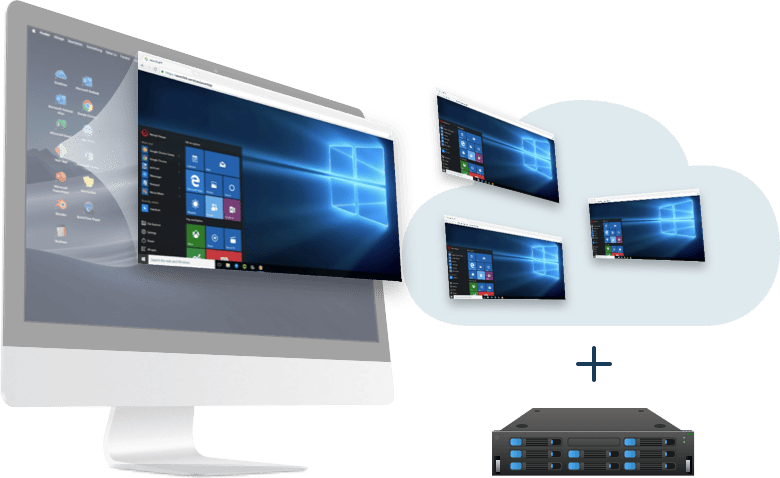The replacement of physical PCs and stationery workspaces through virtual solutions is gaining ground. Using virtual desktop infrastructure (VDI) provides you with the opportunity to centralise almost all administrative tasks on one virtual server in a data centre. This raises the question of the operating principle, the possibilities as well as the strengths and weaknesses of a VDI.
What is a Virtual Desktop Infrastructure (VDI)?
In general, virtual desktop Infrastructure means the hosting of desktop systems on virtual machines (VM). Here, the virtual machines are located mainly on a virtual central server and host the desktop systems as virtual desktops. This represents the virtual desktop infrastructure as a variation of the client server mode.
In the same context, this is also referred to as server-based computing. In the market place, you will find numerous different VDI systems of various vendors.
Virtual Desktop Infrastructure Systems and Clients
Available are commercial VDI solutions as well as Open Source concepts, including clients. Some of the most important vendors of VDI offers are for example Dell, HP, Fujitsu, Microsoft or oneclick. Open Source offers include for example QVD Community Edition as well as the Linux Terminal Server Project.
Virtual desktop infrastructures enable you to use different types of clients. Clients differentiate themselves primarily with regards to certain functions, whereby a clear distinction between client types is difficult.
Thick clients (also called fat clients) are full-featured systems, which have a powerful pre-installed software and represent a virtual desktop of a complete server environment. Thick clients are characterised by having their own and a remote desktop. This makes the thick client deployable for local and remote desktop applications.
Thin clients are used predominantly to display virtual desktops. The hardware of thin clients is generally less powerful as the hardware of thick clients. It remains reduced to the components required for the display of the virtual desktop. Independent mass storage such as hard disks are no longer required, nor are drives. Thin clients generally also do not need cooling fans as their CPU and other hardware components hardly give off heat. Therefore, they work silently. The reduced hardware enables a significantly longer lifespan of the thin client in comparison with a fat client, which means that hardware has to be replaced notably more infrequently.
Another even considerably more reduced device, which contains even less components than a thin client is called a zero client. Such clients are generally immediately ready-to-use without any administrator involvement. Therefore, zero clients save you a separate configuration or adaptation to the remote access. The use as virtual desktop is possible immediately after connection of the input devices. Zero clients are mainly formed from an inconspicuous box, which can be directly connected with the screen, network as well as keyboard and mouse.
Due to their reduced set-up, zero clients are characterized through their considerably lower energy consumption in comparison to thin and fat clients. Purchasing costs are also lower. Most of the time, software is also no longer required or only minimal software is in use.
A particular attractive model in the field of business solutions on offer is Desktop-as-a-Service (DaaS). Here, the complete responsibility of hardware and software is outsourced to a provider. Virtual desktops are hosted in the cloud of the provider. In this way, DaaS has revolutionised desktop virtualisations by one further business ready solution.
Benefits and Strengths of Virtual Desktop Infrastructures
Centralisation of the administration on virtual servers offers you a decisive advantage, in that updates turn out significantly easier. Only a few images have to be updated rather than several clients. Possible compatibility issues or conflicts between older and newer versions no longer occur, or only arise in one place. You also benefit from an automation of the deployment process of desktops.
Data back-up of users is also simpler as the storage takes place centrally right from the beginning.
Virtual desktop infrastructure also offers you some benefits during application. As no data is stored locally, it can therefore not be infected locally. This means that there is no requirement for a separate virus protection or an individual firewall for each client.
VDI also offers cost benefits as there is no longer a need for price-intensive, complete PCs. Lean and cost efficient thin clients use the resources of the server, which means that they also experience more efficient utilisation. There is also the added advantage, that the life cycle of the hardware and software is no longer interconnected. New operating systems or programmes no longer require procurement of new desktop PCs.
A virtual infrastructure also leads to a relief of administrators. As separate desktop PCs are replaced by cost effective clients, in case of a failure it is possible to simply use a replacement device. Hence admins no longer need to be on site to conduct trouble-shooting, which can be time-consuming. Other defect vulnerable components, such as fans and hard disks are omitted.
Disadvantages and Weaknesses of the VDI
In practice, the implementation of virtual desktop infrastructures often turns out to be complex and cost intensive. Here, the initial investment costs play an important role and they are the result of the considerable requirements on a desktop environment. High costs are caused by central storage area network (SAN) as well as high performance networks. There is also the high expenditure of services and components, which are required for a smooth operation of the VDI environment. This includes for example high availability or shared storage. For this reason, you should evaluate each individual case and the costs and benefits, comparing traditional desktop systems and VDI. You will find another disadvantage in the limited user experience. As VDI solutions are mainly connected with many protocols, this limits possible applications significantly. There is also no option of off-line use of a virtual desktop solution.
oneclick AG: Your competent Partner for Cloud Computing Systems
oneclick AG offer you and your company comprehensive solutions for the automation and digitalisation of your workspaces. We are happy to develop tailored cloud computing systems for your individual requirements. We have noted that the stationery workspace is becoming rarer and employees more mobile. Also whilst travelling, high performance systems are required. This is why we want to make centrally hosted solutions accessible everywhere. Security and user experience are to remain guaranteed. But at the same time, administration should be possible in a simple and cost-efficient way.
Since 2014, we have supported companies in different lines of business and industry sectors with the implementation of digitalisation of their processes, irrespective if they were end customers, public sector or IT service providers. Numerous awards, certificates and references of satisfied customers endorse our performance and reliability.
oneclick™ Virtual Desktop Infrastructure (VDI)
With our VDI packages you get an immediately usable, high-performance and preconfigured solution that is optimal for working in small or medium-sized companies or larger departments. oneclick™ provides a hardened system landscape with increased malware protection for the convenient, group-wide and, in particular, secure provision of applications and data. Accessible via the browser at any time and from any place, the oneclick™ Virtual Desktop Infrastructure enables efficient user collaboration.
Start today with your oneclick™ Virtual Desktop Infrastructure and select the VDI package that suits you best based on your personal performance requirements!
Image sources:
Image 1 © dedidam net | flickr.com
Image 2 © Aichi8Seiran | pixabay.com
Image 3 © Lee Campbell | pexels.com




